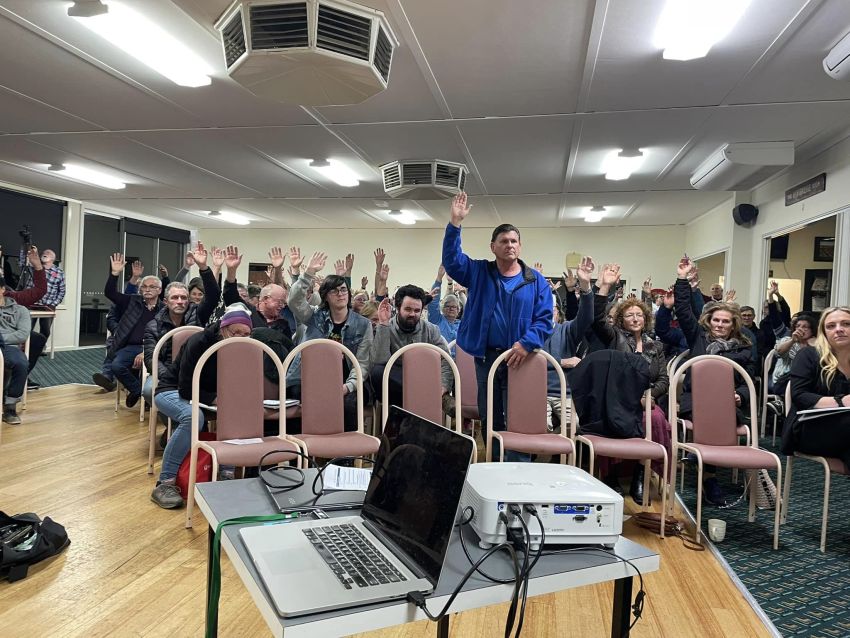
Close to 150 residents packed out the Lara Golf Club on August 21 to raise concerns about Prospect Hill International (PHI)’s waste-to-energy incinerator proposal. The meeting was organised by Geelong Sustainability.
PHI wants its plant to service Greater Geelong and west metropolitan Melbourne. It aims to process approximately 400,000 tonnes of waste (that currently goes to landfill) and generate 35 megawatts of electricity each year.
Ella George, Labor MP for Lara, Dr Sarah Mansfield, Greens MLC for Western Victoria, Sarah Hathway, City of Greater Geelong Windermere Ward Socialist Alliance councillor, Lara residents Les Dew and Charles Street, and Dr Trevor Thornton, lecturer in hazardous materials management at Deakin University also addressed the forum.
Dr Peter Tait, from the Australian National University, addressed the potential health impacts of waste incineration. Tait is a lead author of “The health impacts of waste incineration: a systemic review” and is co-convener of the Public Health Association Australia Ecology & Environment Special Interest Group. He said there was enough evidence to give legitimacy to residents’ concerns.
Lara, in Geelong’s outer North, includes urban development as well as semi-rural and farming areas. The suburb is also host to Serendip Sanctuary, Hovells Creek and sits at the base of the You Yangs Regional Park.
The Environmental Protection Authority (EPA) Victoria first consulted the community in 2021: 95% of submissions opposed the project. After that everything went quiet with locals assuming it was not going ahead.
PHI applied to the EPA in February for a development license to build the facility. This led to another round of community submissions, which the EPA is now reviewing.
Residents are concerned about the proposed incinerator’s proximity to residential, farmland and other industries. The site is just 450 metres from a Viva Energy LPG holding facility, with above ground and below ground LPG storage tanks.
Lara residents point out that some bedroom windows would be just 350 metres away. Noise pollution and trucks bringing waste are other concerns.
The incinerator will use 2.5 mega litres of potable water a day and there are no plans for the containment or treatment of run-off water. There is also no mitigation for the possibility of it running out to Corio Bay, causing further pollution. Concerns were also raised about the impacts on livestock and farming.
A health assessment study which PHI included in its application did not find any problems. But the consultants excluded the closest residential areas of Lara and Corio.
Further, the waste tonnage numbers do not add up.
PHI states it will process 400,000 tonnes of waste a year that would otherwise go to landfill.
The current total red top bin tonnage from residents in all local government areas in Western Victoria is 88,464 tonnes a year, based on 2018–19 figures. If you include commercial and industrial waste, it would rise to 108,811 tonnes a year.
This means the facility would be running at 27% of capacity. This begs the question of whether other waste will be trucked in from elsewhere in Victoria, interstate or shipped in via Corio Bay.
Waste-to-energy incinerators are the not solution: they emit the most emissions when they start up and shut down, which is why many plants run 24 hours a day.
Victoria has a number of waste-to-energy incinerator projects seeking approval. Some, such as Laverton North, have been given the go-ahead. Melton City Council, which is supporting the facility, expects it to operate from next year and process 200,000 tonnes of municipal waste a year.
In Dandenong South, hundreds of retirement village residents are opposed to a second waste-to-energy facility proposed for the area. The first waste-to-energy facility was granted in 2021, despite Greater Dandenong Council’s objections.
The Victorian Greens claim that waste incineration is greenwashing, at best. These plants turn waste into a commodity and local councils are then forced into long-term waste generation contracts to keep feeding their furnaces.
Environmentally friendly?
Proponents claim these plants are environmentally friendly because they reduce landfill. However, simply burning waste rather than burying it removes the impetus for more innovative ways to reduce, reuse, repair and repurpose.
While landfill is not the ideal long-term solution either, studies show that carbon dioxide emissions released from landfill are less than what is being generated by these plants.
Residents are now waiting for EPA Victoria to make a decision on a development licence. It can approve the application as is, approve it with conditions or reject the proposal.
The minister is also required to grant a planning permit if it is given the go-ahead. Recycling Victoria would be the regulator and the City of Greater Geelong Council would be the referral authority, meaning it can only make comments and raise concerns. These are all pressure points in the next few months.
Lara and Geelong residents told the Q&A that if this type of plant isn’t good for our community, they should not be set up anywhere else. They have been banned in the ACT in 2020 and New South Wales banned them in the Greater Sydney area in 2022, with limited exceptions. Residents in Sydney’s West ran an 8-year campaign to stop an incinerator, with proponent Next Generation only this month discontinuing its appeal.
[The event was live-streamed and can be viewed at The Sustainable Hour Facebook page.]